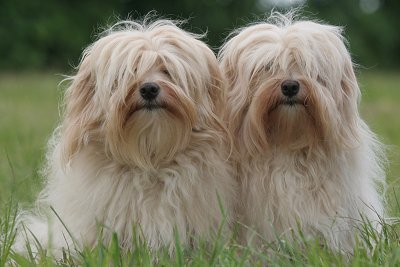Facts and History Concerning Havanese Dogs: The Toy Breed That Loves to Make Pet Owners Laugh
Havanese dogs are quickly rising in popularity according to AKC statistics. While the breed was virtually unknown only ten years ago, it ranked 55th in popularity in 2010 and shot up to 35th in 2015. The Havanese’s toy stature, sturdy build, gentle temperament, and easy going nature all contribute to the breed’s new-found popularity.
The Havanese Dog’s Appearance
The most noticeable feature of the Havanese is their thick, wavy coat. Although the hair appears extremely dark, the texture is light and silky to the touch. And though these dogs have an abundance of hair, the classic Havanese look is not sculpted or overdone. The overall appearance of the coat will suggest a playful, carefree look. Havanese coats exhibit a variety of colours and patterns.

The breed can be white, cream, gold, red, fawn, chocolate, silver, charcoal blue, black, and any shade between. Havanese dogs are often a combination of two or three of these colours. For example, a cream dog may have ears and feet of a darker buff or a black dog may have white tips on its tail and paws.
Several colouring patterns are common to the breed. Parti patterned dogs are primarily white with up to 50% of random markings in another colour. Dogs with a pied pattern are mainly coloured with white paws, legs, the tip of tail, chest, and neck. Havanese dogs may also be primarily of one colour with white, cream, or silver markings. Some Havanese are marked with tan, or silver points on the underside of their ears, cheeks, eyebrows, chest, muzzle, and legs. Dogs with stable patterns have hairs that are tipped in black. Brindle dogs often have a dark mask and hairs of different colours scattered throughout the coat lending the dog a mottled or striped look.
Havanese wears a funny expression on their rounded face. Their nose and eyes are dark except dogs with chocolate coats. These dogs will have a liver nose and amber eyes.
Havanese are classified as a toy breed but are remarkably sturdy. Dogs are meeting AKC standards measure between 8 ½ and 11 ½ inches in height. Their body is slightly longer than tall. The breed has a rear end that’s just a bit taller than the shoulders. It contributes to the dogs’ recognisably springy gait. When a Havanese is happy, their tail is curled over their back waving merrily like a flag.
Havanese Temperament
Havanese dogs were bred to be companions. Because of their high desire to please their masters, they are easily trainable dogs. If their antics receive a chuckle once, they’re bound to try it over and over just to keep their owner laughing.
Within this breed are a variety of personalities. Some are on the go and perfect for playing; others just want to lie in their owner’s lap and calm down.
Regardless of their energy level, all Havanese have a deep need for frequent contact with their owners. This is not a breed owner can pat on the head then walk away. These dogs also may become destructive when left alone for extended periods of time. The Havanese is not the right breed for someone hoping to have at home a dog while they work.
Havanese dogs are an excellent choice for families. They get along with children well and are instant friends with any stranger. They also enjoy the company of a wide variety of animals. They are an easy going breed and incredibly accepting of a wide range of personalities, life styles, situations, and activities.
History of the Havanese
Though the Havanese breed is enjoying a recent surge in popularity, it was only recognised by the AKC in 1996. Its origins stretch back at least three hundred years to the colonial plantations of Havana Cuba. As Spanish aristocrats journeyed to the tropical island, they brought with them their lap dogs from home. Many believe the dogs they carried off the ships were of the Tenerife breed. These Tenerife dogs also originated such popular breeds as the Maltese and bichon fries.
The aristocrats bred their dogs to each other, and eventually, a unique breed developed. After many years under the hot Havana sun, these dogs acquired their characteristic, silky coat which insulates their body from the heat.
Before adding a Havanese to the family, individuals should do their research carefully. Havanese dogs have particular care and grooming requirements. And since proper breeding for temperament and early socialisation are essential to ensuring the lovable personality associated with the breed, these puppies are best acquired from knowledgeable and reputable breeders.